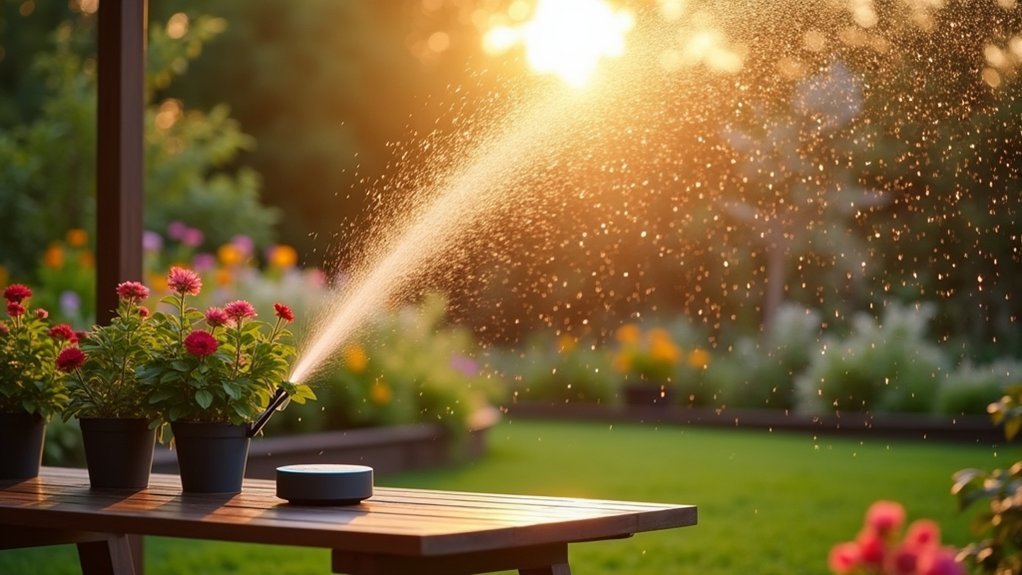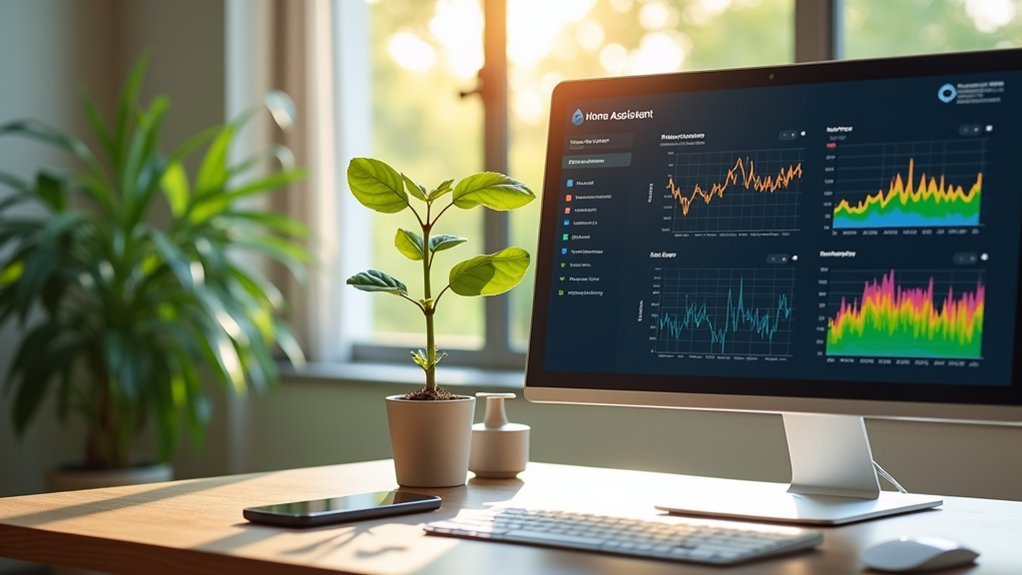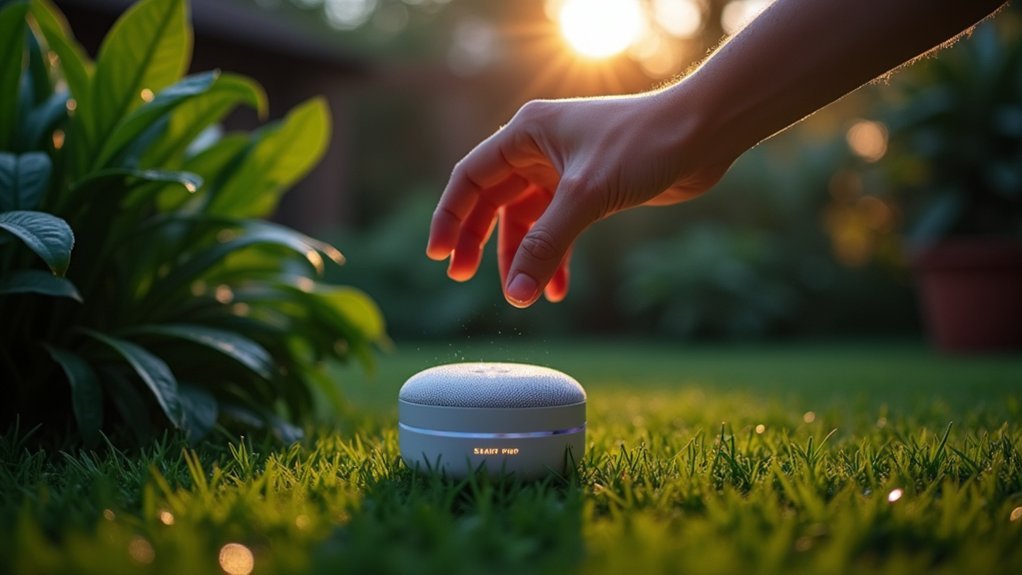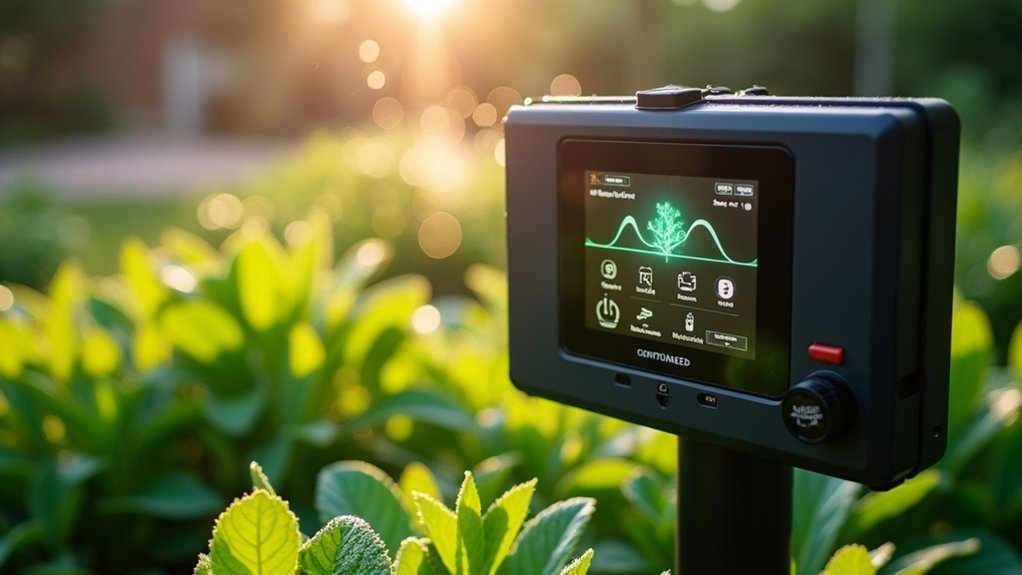Setting up irrigation commands for Home Assistant lets you control watering schedules hands-free while optimizing water usage based on real-time data. You’ll conserve water, reduce bills, and improve plant health through precision watering that adapts to weather conditions. With simple hardware like ESP32 microcontrollers, soil moisture sensors, and solenoid valves, you can create customized voice commands for specific garden zones. The perfect marriage of convenience and garden care awaits in the details below.
Understanding the Benefits of Voice-Controlled Irrigation

While traditional irrigation systems require manual adjustments and monitoring, voice-controlled irrigation offers a revolutionary approach to managing your garden or lawn.
You’ll conserve water through precise distribution based on real-time data, while enjoying the convenience of hands-free control from anywhere in your home.
This technology seamlessly integrates with your existing smart home setup and irrigation infrastructure. You’ll save money through reduced water bills and lower energy costs associated with pumping.
Your plants will thrive thanks to optimized watering schedules that adapt to weather conditions, soil types, and seasonal changes. The integration with weather data allows your system to automatically skip watering when rain is forecasted.
Smart irrigation adapts to your garden’s unique needs, delivering perfect hydration through all seasons.
The time you save with voice commands allows you to focus on other gardening tasks, making your entire outdoor maintenance routine more efficient and environmentally sustainable.
Essential Hardware Components for DIY Smart Watering
Building your own smart irrigation system requires several key hardware components working together.
You’ll need a microcontroller like Arduino Uno or ESP32 to serve as the brain of your system. ESP32/ESP8266 models are particularly useful for their Wi-Fi capabilities, allowing seamless integration with your home assistant. The Wemos D1 Mini is an excellent option that provides Wi-Fi connectivity while maintaining a compact form factor.
For sensing conditions, soil moisture sensors are essential to determine when plants need water, while rain sensors prevent unnecessary watering.
Temperature and humidity sensors can further optimize your watering schedule.
To distribute water, you’ll need mini water pumps or solenoid valves controlled by relay modules.
Don’t forget basic components like 5V/12V power supplies, jumper wires, and breadboards for prototyping your circuit connections before final installation.
Step-By-Step Integration With Home Assistant

Integrating your irrigation system with Home Assistant transforms simple automated watering into a sophisticated solution that responds to both your schedule and environmental conditions.
Begin by connecting ESP-based microcontrollers to your Home Assistant environment using ESPHome. Install HACS and add the Smart Irrigation custom component to enhance your automation capabilities. The system supports unlimited controllers and zones for complex irrigation arrangements without requiring extensive scripting.
Configure zones in the component to match your garden’s layout and connect to a weather service like OpenWeatherMap for real-time data.
Set up automations that calculate moisture balance by comparing evapotranspiration with precipitation. Program these automations to trigger your irrigation relays when moisture levels fall below your thresholds.
Don’t forget to create notification scripts that alert you when watering cycles complete, automatically updating moisture balances in your system.
Creating Custom Voice Commands for Garden Zones
You’ll need to create distinct voice commands for each garden zone to effectively manage your irrigation system.
Set up zone-specific trigger phrases like “Turn on the front lawn sprinklers” to target watering in precise areas.
Command sequence shortcuts can streamline your routine by combining multiple actions, such as scheduling regular watering cycles or linking irrigation decisions to weather forecasts. For better interaction with your irrigation system, consider creating personalized sentences that Assist can understand and execute properly.
Creating Custom Voice Commands for Garden Zones
Once you’ve connected your irrigation system to your smart home platform, creating custom voice commands for your garden zones transforms how you interact with your outdoor watering setup.
With Home Assistant’s Assist feature, you can map natural language commands to specific irrigation actions for each zone.
Keep your command phrases simple and memorable—”water the front lawn” is better than complex instructions. Configure Home Assistant to recognize variations like “irrigate,” “sprinkle,” or “water” for flexibility.
Assign clear labels to each zone to improve voice recognition accuracy and reduce confusion.
For enhanced functionality, integrate these commands with sensor data, allowing conditional responses like “water zone two only if soil moisture is below 30%.” Creating scripts with entity IDs will ensure your automations properly control the specific irrigation components in your system. This approach gives you hands-free control while maintaining irrigation efficiency.
Zone-Specific Trigger Phrases
Carefully selecting the right trigger phrases for each irrigation zone forms the foundation of an effective voice-controlled watering system. Choose short, distinct keywords that relate to your garden’s physical layout while avoiding similar-sounding terms that could trigger the wrong zone. For optimal performance, consider integrating with local voice assistants which offer faster processing compared to cloud options.
| Zone Example | Good Trigger | Poor Trigger |
|---|---|---|
| Front Area | “Front lawn” | “Grass area” |
| Vegetable Patch | “Garden beds” | “Plants” |
| Side Yard | “East border” | “Side area” |
Position microphones strategically to capture commands clearly, especially if you’ll be speaking from different areas of your property. When setting up your phrases in Home Assistant, verify each zone responds correctly before finalizing. This careful naming approach not only improves recognition accuracy but also makes your system more intuitive to use during everyday gardening tasks.
Command Sequence Shortcuts
Building on the foundation of zone-specific trigger phrases, command sequence shortcuts take your irrigation system to the next level of convenience and efficiency.
These custom commands bundle multiple actions into a single voice command, eliminating repetitive controls and saving valuable time.
You can create shortcuts that not only manage different garden zones but also synchronize with other smart home activities. For example, say “Evening garden routine” to water specific zones while dimming outdoor lights and adjusting your thermostat. By leveraging the custom intents system, you can create tailored irrigation commands specific to your garden needs.
Integration with Alexa, Google Home, or Siri enables seamless vocal control without opening apps.
Set up event-triggered sequences that respond to weather changes or soil moisture readings for truly automated irrigation.
These shortcuts enhance accessibility for all household members, including those less familiar with your system’s technical details.
Weather-Responsive Automation Through Voice
While traditional irrigation systems operate on fixed schedules regardless of conditions, voice-controlled weather-responsive automation represents a significant leap forward for smart home gardeners.
By integrating voice assistants with Home Assistant, you’ll gain hands-free control over your irrigation system while leveraging real-time weather data.
Simply ask “Is watering needed today?” and your system can check rainfall forecasts before responding. During heatwaves, say “Increase garden watering by 20%” to adjust for extreme conditions.
Your voice commands can trigger complex automation sequences that consider soil moisture readings, temperature patterns, and precipitation data before executing. The system automatically prevents irrigation when rainfall exceeds certain thresholds, such as 4mm yesterday or 2mm today.
This approach isn’t just convenient—it’s essential for water conservation and plant health.
Voice automation also makes smart irrigation accessible to everyone, including those with mobility limitations who might struggle with traditional controls.
Troubleshooting Common Voice Control Issues

Voice control issues with your irrigation system can quickly turn a convenient automation into a frustrating experience. When commands aren’t recognized, enable debug recordings by adding `assist_pipeline: debug_recording_dir: /share/assist_pipeline` to your configuration.
Review these .wav files to identify audio quality problems. For poor audio capture, adjust your settings: increase `noise_suppression_level` (up to 4) to reduce background noise, set `auto_gain` to amplify quiet speech, or tweak `volume_multiplier` for better detection.
Just remember excessive settings may cause distortion. Check network connectivity between your devices and Home Assistant, ensuring they’re not separated by VLANs or firewall restrictions.
Monitor logs for specific errors, and consider adding LED indicators to confirm wake word detection is working. If your assistant is missing from Settings, ensure you have the assist_pipeline: entry properly configured in your configuration.yaml file. After troubleshooting, remove debug settings to free up disk space.
Expanding Your System With Advanced Sensor Integration
Beyond basic voice commands, integrating environmental sensors transforms your irrigation system into a truly intelligent water management solution.
By connecting soil moisture probes, you’ll water only when the ground actually needs it, preventing waste while maintaining peak plant health.
Water when needed, not by schedule—soil sensors deliver perfect hydration with maximum conservation.
Weather sensors take this efficiency further—rain detectors automatically skip scheduled waterings during precipitation, while temperature and humidity monitors adjust for seasonal changes.
You can integrate local weather forecasts to make proactive decisions about tomorrow’s irrigation needs.
For complex setups, multi-zone coordination allows customized schedules per area based on plant types and sun exposure.
Visualize all this data through companion dashboard cards that display upcoming schedules and historical patterns.
When sensors, automation scripts, and voice control work together, you’ll achieve remarkable water conservation while enjoying healthier landscaping.
The Hunter Hydrawise integration enables you to implement custom actions for advanced control of your irrigation system through Home Assistant.
Frequently Asked Questions
Can Irrigation Systems Work During Internet Outages?
Yes, properly configured irrigation systems can work during internet outages if they use local control. You’ll need local automation scripts, physical controllers with direct valve connections, and no dependency on cloud weather services.
How Do I Winterize My Automated Irrigation System?
To winterize your automated irrigation system, shut off the water supply, run one sprinkler briefly to relieve pressure, then blow out water using an air compressor (keep under 50 psi). Finally, turn off your controller completely.
Will Electromagnetic Interference From Nearby Equipment Affect Valve Operation?
Yes, electromagnetic interference can disrupt your valve solenoids. Strong EMI from nearby electrical equipment may cause buzzing, erratic operation, or valve failure. Shield your wiring and route it away from EMI sources for better performance.
Can I Integrate With Rainwater Harvesting Systems?
Yes, you can integrate rainwater harvesting systems with Home Assistant. Use tank level sensors, automated valves, and custom automations to switch between rainwater and municipal sources based on availability and plant moisture needs.
How Much Power Does a Home Assistant Irrigation Controller Consume?
Your Home Assistant irrigation controller typically uses minimal power – about 1-5 watts for ESP32/ESPHome controllers. The valves draw more power (around 5-10 watts each) only when actively running your irrigation zones.
In Summary
You’ve now set up a powerful voice-controlled irrigation system that saves time, water, and money. By integrating your sprinklers with Home Assistant, you’re creating a smarter garden that responds to both your commands and environmental conditions. Don’t stop here—continue expanding with soil moisture sensors or rain detection for even more efficiency. Your garden will thank you, and you’ll wonder how you ever managed without it.





Leave a Reply